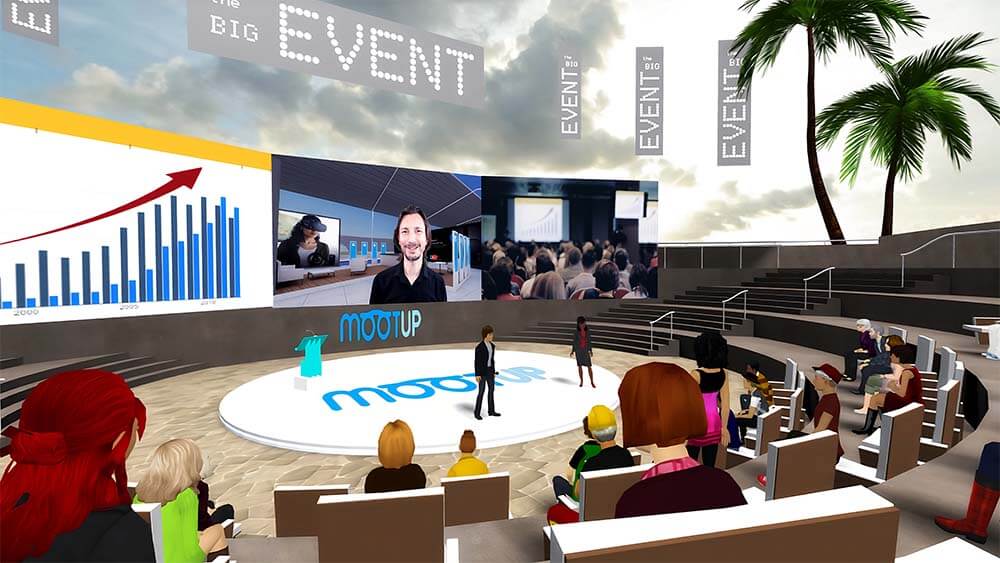
MootUp offers a variety of ready-to-use virtual rooms for events or work sessions, including a virtual event auditorium. (Courtesy of MootUp)
Convene editors gathered ideas and insights from a variety of sources to examine what the metaverse is and how business events professionals are and will be using it in the future. This is one in a series of stories (see list at bottom) from the March/April issue of Convene.
For Danny Stefanic, the metaverse is nothing new — the CEO of 3D virtual and hybrid event platform MootUp started the Virtual Reality Association in Australia nearly 30 years ago. The fundamentals of the metaverse, Stefanic told Convene during a conversation in the metaverse on his MootUp platform, “are the same and have been for decades.”

Danny Stefanic
Now that face-to-face events are back in full swing and knowledge workers have returned to offices at least part-time, has interest in virtual environments waned? Stefanic said he has seen the opposite. Events are still being held in 3D virtual environments — and the hybrid workplace has created the latest growth opportunity for the metaverse. Stefanic said that’s because this online platform can offer what’s missing from traditional video-conferencing solutions. Those are things like “feeling part of the same experience, having a shared experience, and the ability to bond and have people feel like they belong to an organization or an event,” he said. “The metaverse gives you the ability like we’re sitting here” — our avatars were sitting across from each other in chairs at an outdoor plaza bordered by palm trees — “to run into each other, to have a serendipitous chat like you might around a water cooler.”
In a “flat” video-conferencing environment, Stefanic said, “the audience is kind of resigned to the text chat on the right-hand side, or if you’re lucky, a few dozen thumbnail pictures of some of the audience. With the metaverse, the spaces are persistent, so they evolve over time.”
Workshops or hackathons in the metaverse can feature white-boards and “people can pin documents and other things in there, and they become living spaces with value just like you have when you’re working with documents,” he said. “They develop over time and the spaces then become personal. They become relevant to the people in the context.”
The metaverse also gives participants “agency over their own experience,” he said. “If you watch a Zoom webinar and I watch a Zoom webinar, we’re both pretty much having the same experience. And apart from the real-time chat, maybe some Q&A, if I were to watch the recording, it may not be that much different from me being there. These tools are awesome for people presenting content — we’ve got the best tools in the world for video production and presentation. But the audience to each other is left invisible. But when you put them into a virtual world, they become visible to each other with avatars — or we also support video in our platform — and it’s an actual three-dimensional place that they navigate around. It’s their personal journey, and it creates a stack of associations in your brain of what you are doing and how the event was. We describe it as a ‘lean-forward’ experience as opposed to a ‘lean-back’ experience.”
Stefanic said there are four main areas that organizations gravitate towards in the metaverse: for meetings and events, learning and training, marketing (in terms of bringing the audience on a brand journey), and most recently, as way to connect remote workers. Organizations are struggling with cultivating a sense of belonging among employees who don’t share an office, he said, and Teams or Zoom calls don’t solve for that.
“There’s really a lack of connection going on,” Stefanic said. “So, the metaverse is being used by many organizations now as a corporate intranet but in 3D. And yes, you might have an all-hands meeting, you might have a hackathon or a sales kickoff or maybe a meeting, but it’s part of a permanent fixture, which is there to engage both people who are separated by geography and those who are now remote workers. The term I sort of coin for that is ‘un-remote work.’ We don’t want to be remote — we want people to feel the opposite of that. And now these organizations are not looking for one-off events or just to focus on learning and training, instead they’re looking to make the metaverse a permanent part of their enterprise ecosystem.”
Michelle Russell is editor in chief of Convene.
ON THE WEB
Read how a range of events were hosted on MootUp, from the 75th anniversary of the UN event to an annual event of the Association of African American Financial Advisors at mootup.com/case-studies.
The Complete March/April CMP Series
- Meeting in the Metaverse
- The Metaverse and Events, According to ChatGPT
- What Does an Event in the Metaverse Look Like?
- What Exactly Is the Metaverse? Here’s One Expert’s Take.
- A Virtual Tour Through Atlanta’s Convention Offerings
- How the Metaverse Can Solve the Limitations of Physical Events
Earn one clock hour of CMP certification by visiting the Convene CMP Series page to answer questions about these stories. The Certified Meeting Professional (CMP) is a registered trademark of the Events Industry Council.

